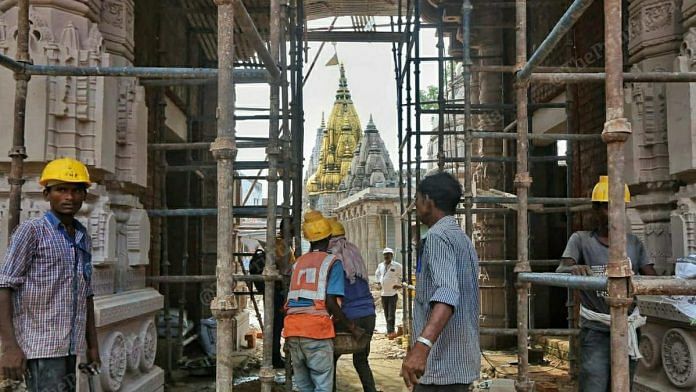Varanasi: If you are not a VIP, a visit to the Kashi Vishwanath Temple in Varanasi would look something like this — traffic moving at a snail’s pace, serpentine queues of people jostling and pushing inside narrow lanes, and just about managing to catch a glimpse of the deity, Shiva, before they are forced to move on.
All that is set to change come December, thanks to the Kashi Vishwanath Dham project, which has been designed to make the visit a memorable one for pilgrims to the Shiva shrine, as well as other tourists who converge on the ancient city.
However, owing to the impact of the Covid pandemic, the project is racing to meet the November 2021 deadline, just a few months before the crucial Uttar Pradesh assembly elections.
ThePrint visited the project site Monday, and despite it being an official holiday on account of Janmashtami (Lord Krishna’s birthday), construction was on in full swing with excavators, cranes and trucks.
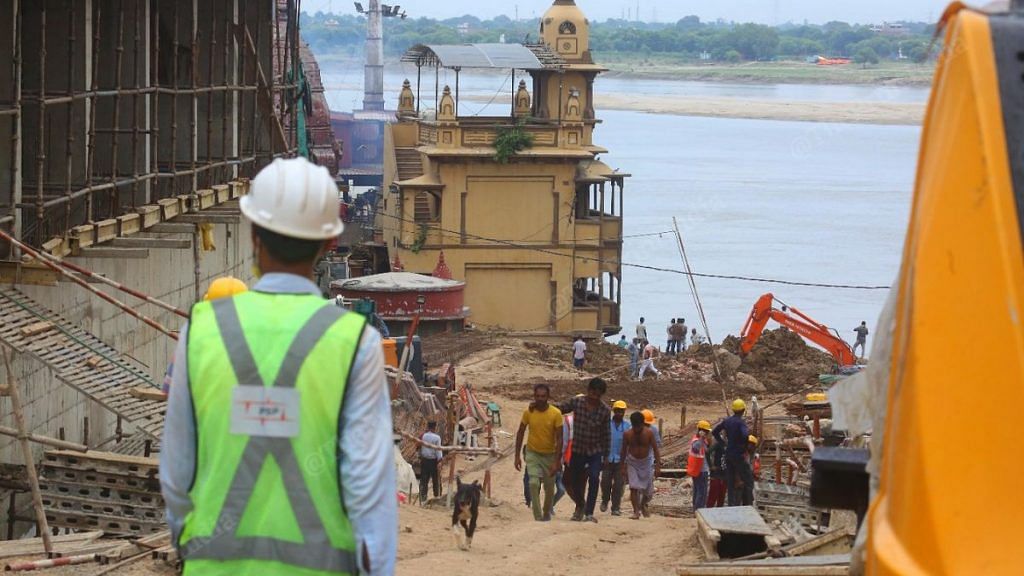
According to Deepak Agrawal, divisional commissioner of Varanasi, more than 1,200 people are working round-the-clock in shifts to ensure that the delay caused by the Covid-19 pandemic is made up for.
“We are going to scale it up to 1,800 workers to ensure timely completion. We are planning to complete it by November this year,” said Agrawal.
The administration claims the work was also impacted by recent floods. “This time, the water level has been higher than the average. Some of the work around the ghats has been slightly delayed, but we are confident of completing it by November,” Agrawal said.
The cost of the project, which was initially Rs 339 crore (excluding GST), has now crossed Rs 400 crore. “During the course of the project, a number of temples were rediscovered, so we had to revisit the designs. We have sent the revised cost of Rs 400 crore to the government for approval,” the commissioner said.
Also read: Modi’s Hindutva 2.0 written on Varanasi walls: Temple restoration, not mosque demolition
What does the project entail?
The Kashi Vishwanath Dham project, launched by Prime Minister Narendra Modi, the Varanasi MP, in 2018, will see the Kashi Vishwanath temple being connected with the banks of the river Ganga through three decorated gates.
The project will be spread across 5 lakh square feet. Contrast that with the earlier area of the temple, which was just 2,700 feet, officials told ThePrint.
The project has been designed by Bimal Patel, the same architect who is in charge of the Central Vista redevelopment in New Delhi.
The temple is to be made accessible to tourists and pilgrims through roads and waterways — people will be able to take boat rides from Khidkiya Ghat and Raj Ghat. Escalators and ramps will ensure easy access from the ghats to the temple.
A new Ganga view gallery is set to provide an unhindered view of the holy river, while a Mandir Chowk (crossroads) will serve as a place for people to sit, relax and meditate. A guesthouse, a spiritual bookstore, a gallery, a museum showcasing the thousands of years of Varanasi’s history, a multi-purpose hall, tourist facilitation centres, food courts and shops are also in the offing, officials told ThePrint.
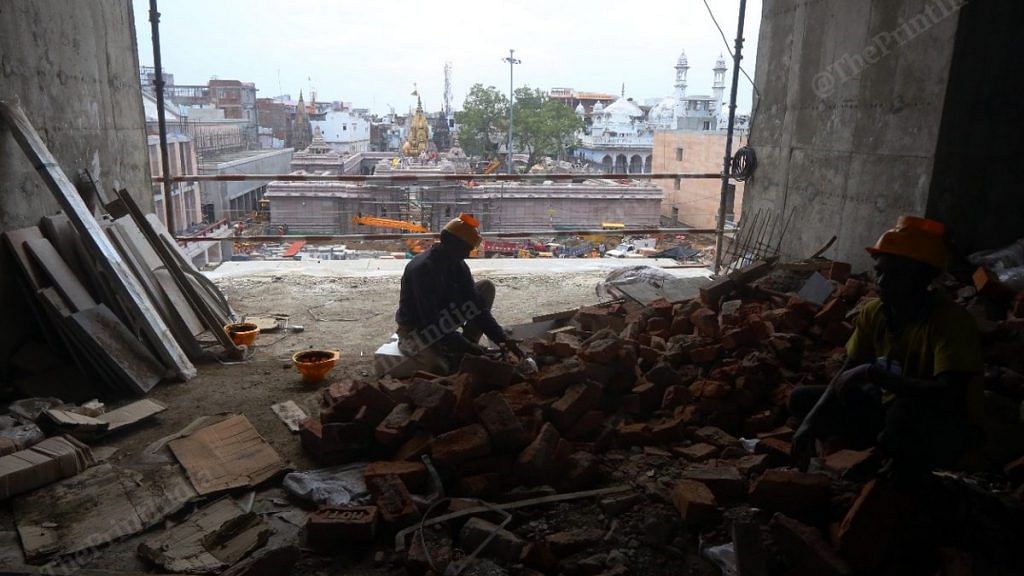
All these facilities are being built to handle the massive footfall of pilgrims in Varanasi, also known as Banaras or Kashi.
An official told ThePrint that during the auspicious month of Shrawan (July-August), around 2.5-3 lakh visitors throng the temple on the first Monday alone, while on Mahashivratri, the number goes up to 4 lakh visitors a day — something the crumbling infrastructure was unable to handle.
Explaining how the project was conceptualised, architect Patel told ThePrint that the current Kashi Vishwanath temple, built in 1780, and many other temples surrounding it were hemmed in on all sides by very dense and haphazard development.
“The many temples and fine houses in the area were insensitively built over, and public spaces were encroached upon. Access to the temple was severely constricted, unsafe and unfriendly to those with mobility issues,” he said.
In 2019, the area between the Kashi Vishwanath temple and the Ganga was cleared for a comprehensive redevelopment, and many have raised concerns that the project will erase heritage and promote ‘mall culture’. However, Bimal Patel contended that the project is designed to reinforce Varanasi’s heritage, culture and spirituality.
“The temple and the redeveloped precinct are a very tiny portion of Varanasi. Much care is being taken to ensure that the additions here fit well with the surrounding area. Retaining its significance in the complex, the temple will be enclosed by an ornate colonnade, creating the spacious and sacred Mandir Parisar. The Mandir Chowk, a large open space in front of the Mandir Parisar, will descend on to the main path leading to the ghats,” he said.
Why the project is needed
The administration cites an incident from 1916 to stress on the fact that the project is the need of the hour.
“In 1916, when Mahatma Gandhi came to Varanasi and visited the temple, he gave a speech at the Banaras Hindu University stating that things have to be improved in the area around the temple,” said divisional commissioner Agrawal.
In the 105 years since, pilgrims and tourists have increasingly felt that navigating Varanasi’s narrow bylanes and ghat steps has been a difficult job. Obviously, things have been worse for senior citizens, women and persons with disabilities, especially since they have to be in queue for several hours.
Another major complaint has been the lack of time pilgrims get to spend inside the temple. This is why a Mandir Chowk is being created.
“Earlier, people used to spend a few seconds inside the temple, and they used to be out in a matter of minutes. They used to spend days coming here, but did not have time to sit and meditate and pray to God. So, we are creating a very big Mandir Chowk, around 40 metres by 70 metres, where people can sit, relax and meditate and spend quality time with their family and friends,” said an official.
The project has been designed with an average of two lakh visitors per day in mind, with three access routes by road and a waterway.
“People can take boats from Khidkiya Ghat and Raj Ghat and simply take a jetty to Jalasen Ghat. We have placed escalators and ramps to ensure easy access from the ghats to the temple,” an official said.
The project will house 24 buildings within the temple complex, Agrawal added. “It will create a number of public amenities to cater to the visitors — guest house, tourist facilitation centres, public amenities like toilets, locker rooms, hospice and a number of other buildings,” commissioner Agrawal added.
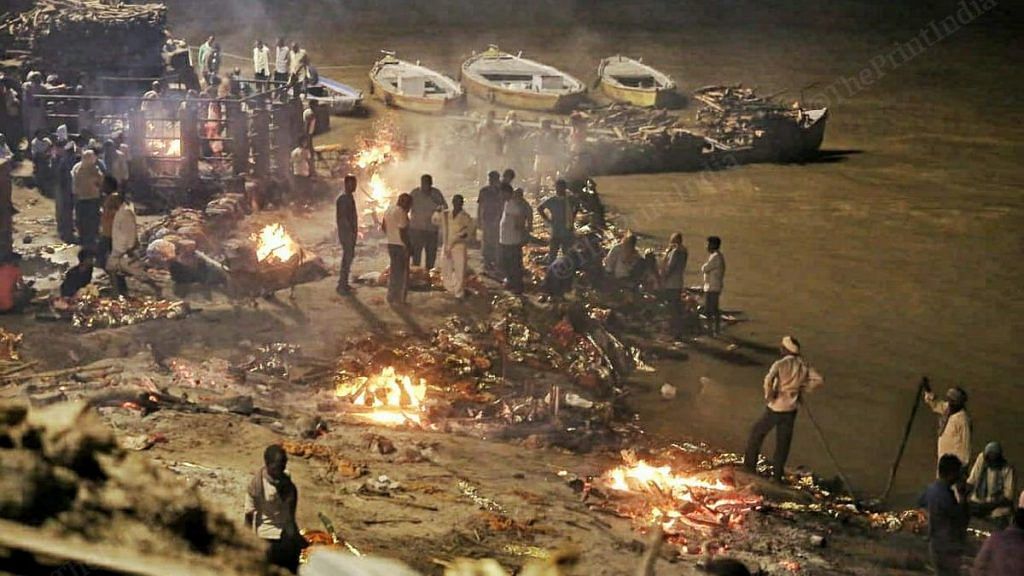
Varanasi is also a city people come to spend their last days in, owing to its association with Shiva and the concept of Moksha — a release from the cycle of births and deaths. To cater to them, the authorities are also building an old-age home, Moksha Bhavan.
“A lot of people have a wish to spend their final days in Kashi, so we are creating a small Moksha Bhavan which will cater to their needs,” an official said.
Manikarnika Ghat, the holiest cremation ground in Hinduism, which stands between the Kashi Vishwanath Temple and the Ganga, is also undergoing changes, with the construction of modern pyres.
“It was in a state that required improvement. So, under this project, we are making platforms in an organised manner, and ensuring that the last rites are performed in a proper way,” an official said.
Also read: BJP MP Subramanian Swamy now wants to ‘reclaim’ Kashi Vishwanath temple
‘No coercion’
The project has not been without controversies. Initially, it faced resistance when the administration decided to take over 400-odd properties for demolition, as they fell in the project corridor. About 60-odd temples housed in some of these properties were also taken over by the administration.
Rs 380 crore were shelled out for the 400-odd properties, and Rs 70 crore were paid for the rehabilitation of shopkeepers and others whose livelihoods depended on the area.
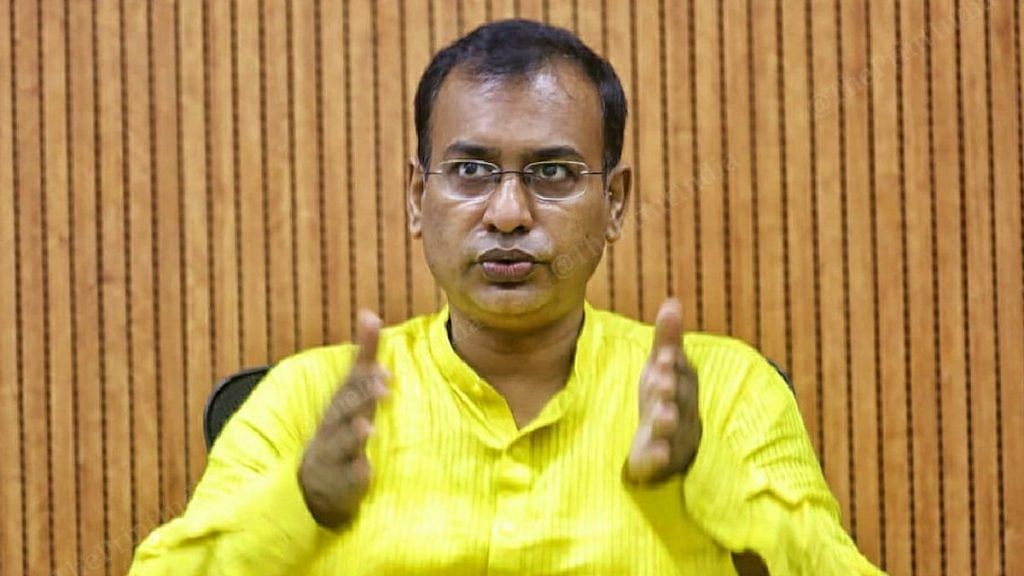
There have been allegations of coercion in this process, which the administration flatly denied. “We did not go through the mandatory process of coercive land. We went through mutual negotiation. We provided twice the value of the market rate. So, in no case was coercion used,” said Agrawal.
He added that a liberal policy was followed with legal tenants, customary tenants as well as encroachers, and any person who was physically occupying that space was suitably compensated. “Over 1,400 people, including shopkeepers and residents, have been compensated,” he said.
Explaining the process through which the 60-odd temples housed in these buildings were taken over by the administration, Agrawal said: “When we set about purchasing the properties which fell under this project, there were around 400-odd properties. When we started removing them, in a number of those structures, we found temples. There were around 60-odd temples. Some were small, some medium-sized and some pretty big. We had to go back to the drawing board and revise our architectural plan. We are restoring all these temples to their former glory,” Agrawal added.
He said efforts are on to find out the history of these temples, with help from the Archaeological Survey of India (ASI) and the department of culture of the Banaras Hindu University.
Temple politics and ‘destruction of heritage’
Varanasi is a major religious destination, and supporters of the ruling BJP have often lamented the fact that Kashi Vishwanath, a temple of great significance in Hinduism, was ignored for years.
Temple politics has always played a crucial role in the ruling BJP’s scheme of things. Ahead of the Uttar Pradesh elections, the BJP has already been projecting the construction of the Ram Mandir in Ayodhya as one of its major achievements. So, if the Kashi Vishwanath Dham is ready by November, the party will be able to showcase it to the people.
A senior BJP leader told ThePrint on the condition of anonymity: “Ram Mandir is an emotive issue. The government will ensure it is constructed in a time-bound manner, but before that comes up, the Kashi Vishwanath Dham will be ready. People here have not forgotten the phrase ‘Ayodhya toh sirf jhanki hai, Kashi, Mathura baaki hai’.
“Even though lakhs of Hindu pilgrims visit this temple, it was in urgent need of help. The previous governments ignored it. The crumbling infrastructure is being fixed and people will be able to offer prayers freely in a good environment.”
Rahul Verma, fellow at the Delhi-based Centre for Policy Research, said of the project: “There are some things that you do for your core constituency, which in this case are Hindus. It is a big project and it is part of the prime minister’s constituency, so it definitely assumes significance. But I don’t think that the BJP will be looking at it from the point of view of electoral benefits.”
The general public of Varanasi is divided in its opinions on the project, with some pointing out that it will ease nightmarish traffic congestion and be a matter of pride and comfort for Hindus, while others say the city’s heritage should have been prioritised.
Abhishek Kumar Srivastava, a banker, is among those who is firmly behind the project.
“This is one of the centres of our faith, and it is important that we ensure better facilities for the pilgrims who come from far-flung areas to offer their prayers,” he said.
“During the month of Shrawan, lakhs of people congregate here, and navigating the narrow lanes becomes a Herculean task. Imagine going to an ancient temple and not even getting a minute to spend, as the police ask you to make way for the thousands behind you in the queue. Through this project, at least we will have a space to sit and meditate and reflect on our heritage. When you go to the Vatican City, you undergo a wholesome experience. This is how it should be,” he said.
However, Yogesh Kesri, who runs a small business, talks about the loss of heritage.
“Banaras is known as a heritage city. ‘Banarasi’ is not just the name for dwellers of this city — it is a mood, an emotion. Those things have been altered. Suddenly, Kashi has been transformed into a mall. Not everything can be seen from the prism of modernism. Some things are definitely good — easing the traffic, ensuring greater cleanliness is all welcome. But don’t transform it into any other modern city,” Kesri said.
Prof. Vishwambhar Nath Mishra, head of the department of electronics engineering at IIT BHU and the mahant (head priest) of the Sankat Mochan Temple dedicated to Lord Hanuman, said there are environmental and cultural costs that the project has not factored in.
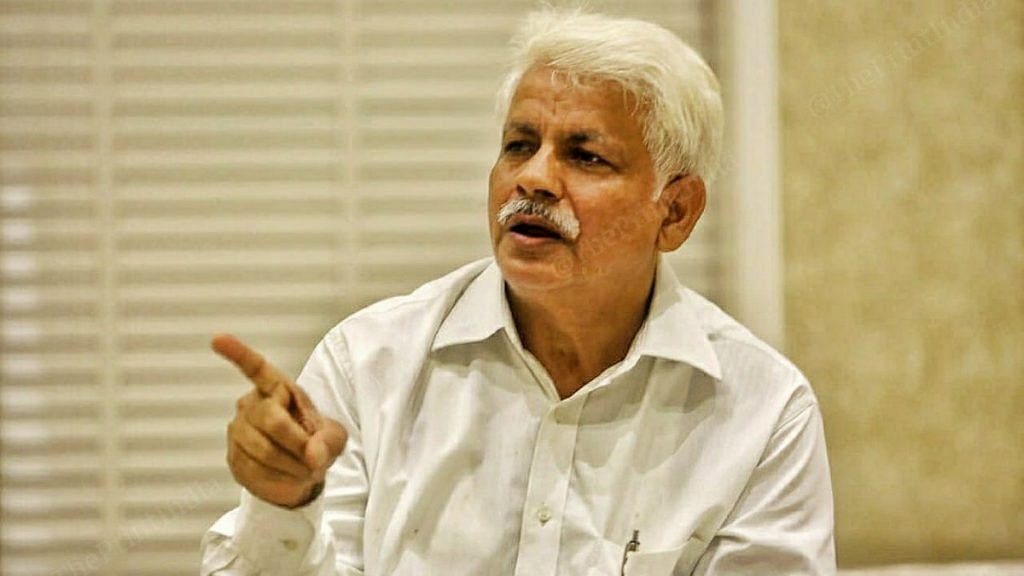
“Kashi is not a tourist place but a spiritual place. Kashi Vishwanath is also considered the dwelling space of Lord Shiva. It is a living heritage; a different ambience. Now you are erasing that and bringing in a new thing, and we don’t know if it will merge with the tradition and culture of Varanasi,” said Prof. Mishra.
“The most unfortunate part has been that the buildings that were demolished, the construction and demolition waste were dumped into the river. Dumping a part of the demolition waste at Lalita Ghat for creation of a platform some 30 metres into the deep channel of the river creates a constriction to the normal flow in that region will act as a spur. Due to this, flow dynamics will be affected. Upstream of this point velocity will reduce and will promote siltation downstream, resulting in a scouring effect in the river channel,” he explained.
“Before all this was done, a detailed study should have been conducted. Banaras is characterised by its narrow lanes and the concept of ‘gharon mein mandir, mandiron mein ghar’. Some of the mandirs have people’s family deities. For thousands of years, they have conserved them… This project should not be a misfit. It should not emerge as a different system in the city. Banaras cannot be modelled on mall culture,” Mishra said.
However, the administration dismissed the charge that the project will lead to change in the course of the river Ganga, a concern also raised by environmentalists and others.
“Right from the very beginning, the entire plan has not only been in the public domain, it has been all over social media too. The site is open to the public, and it isn’t that we have created an iron curtain around it. All the media people, experts… the area is accessible to them. We have taken all the required permissions. This (change in the course of the river) is not true,” he said.
Also read: RSS to go by what ‘samaaj’ thinks on Kashi & Mathura mosques, after seers’ call to remove them
Gyanvapi’s ‘goodwill’ gesture
The Gyanvapi mosque, which shares a wall with the Kashi Vishwanath temple, is also on board with the project.
Earlier this year, the committee that runs the mosque had decided to give a piece of land in the periphery of the complex for the corridor project. The issue had been going on for the past few years, and finally, a decision was taken to part with it as a ‘goodwill gesture’.
“As long as there are no security concerns, we have no problem with the project. And we are quite confident that in the future there won’t be,” said S.M. Yaseen, joint secretary of the Anjuman Intezamia Masjid, Varanasi.
“As far as giving land for the project is concerned, we had three plots including one where the mosque is situated, and there was another one that was used as a police control room. The administration told us that a piece of land was creating obstruction in their proposed plan and we then held a number of meetings with our religious heads. Finally, it was decided to give them that land as a gesture of goodwill. It was not an easy decision but we wanted to set an example,” Yaseen said.
However, commissioner Agrawal maintained that in return, the mosque committee has been provided with a piece of commercial land nearby.
(Edited by Shreyas Sharma)
Also read: Why mosques in rear view mirror, like Kashi’s Gyanvapi, can crash India’s drive into future



